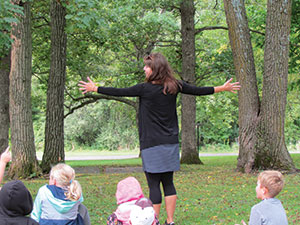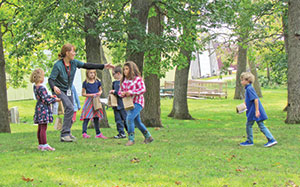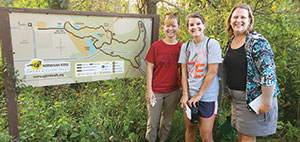The start of the 2020-21 school year presented public schools with difficult challenges due to COVID-19. School administrators and staff worked together throughout the summer to address each challenge that arose. A tactic implemented by Spring Public School to address the needs of the Title 1 Essential Workers is the use of outdoor classrooms.
Spring Grove Superintendent Rachel Udstuen shared, “we have wanted to offer outdoor classes for some time. It just had not happened; now, it is happening.”
Outdoor Playbook explains that outdoor learning goes as far back to Plato and Epicurus in Ancient Greece. Teachers have long understood the importance of learning outside. Michi Saagiig Nishnaabeg scholar Leanne Betasamosake Simpson (2014) writes, “the land is our best teacher.”
As defined by Wikipedia, “Outdoor education is organized learning that takes place in the outdoors.”
During the 2020-2021 school year, there are three multi-age classes at Trollskogen Park. The seventh and eighth-grade curriculum includes time at Roverud Park.
Arriving at Trollskogen Park around lunchtime, one might see Superintendent Udstuen, masked, delivering lunch. Schools use reusable trays and real silverware to serve students’ nutritious lunch. After only four days of school, the students were already familiar with the lunch routine. The bees that gathering around the garbage cans annoyed and scared the students. The teachers saw a learning opportunity.
Jill Bjerke
K/1/2 Grade Class
Jill Bjerke has been a teacher for 10 years, teaching the last four years at Spring Grove Public School. This is her first time teaching in an outdoor classroom. Bjerke is teaching K/1/2 and has 17 boys and girls in her class.

What does a typical day look like for Bjerke and her students? “We have a morning meeting at school. We look at the weather and decide what we will need to wear for the day. Then we set up our day talking about things we are wondering about and discoveries we have made. This sets up our focus for the day and allows us to pack our backpacks for what we need. At the park, we get into our listening spots, and we take a minute to be thankful for being outside. We read stories, journal about the day, have quiet time by our trees where we write and read, eat lunch, and do team building games. We have recess and make discoveries around the park. Right now, we are working on mapping skills. Children are learning about how to use, make, and read maps. We will then talk about how rules change depending on where we are.”
Bjerke’s students eagerly showed off their drawings. One student pointed out the eagle’s nest on his drawing, and another explained that he drew a picture of his house. He pointed out the deer head hanging on the wall in his home. After lunch, the students grabbed their towels and lined up as they listened to their teacher singing instructions. Bjerke asked them to select a tree, which would be their quiet tree.
Bjerke explained, “Initially, I was very worried about wearing a mask all day and what that would mean for the students. I was also worried about trying to keep them safely separated. I read an article last May about Norway and how they were using outdoor learning to help during this time. I thought it was a wonderful idea. We have a beautiful community and park in Spring Grove. I thought this was the perfect opportunity to take this difficult situation and try something new. I have always loved spending time outdoors, as it is my happy place. Throughout my 10 years of teaching, I have always worked hard to bring the outdoors in. I have tree stumps in my classroom to sit on and am always bringing in rocks and other things from outdoors. Well, this year was a chance to switch. I have been reading a lot about Forest Schools and Place-Based Education. All of these types of learning spoke to me. I am very lucky to have a supportive administration, community, and friends interested in this work. I think this type of learning is just the start for me. I am very excited to take on this new journey, and I hope it leads to more programs for our community. The goal is to build a community of students who are ready to solve problems and who will take care of our home. I hope to create a partnership with the community and am looking for projects for us to do to help out the community – which has helped us so much.”
Jennifer Solberg
K/1 Grade Class
Jennifer Solberg has a class of 14 students in kindergarten and first grade. This is Solberg’s first time teaching in an outdoor classroom. She mentioned, “I’m not sure why it took me so long to make this change. It’s so great!”
Solberg describes a typical day in her classroom. “We begin and end each day in the classroom, but spend most of the day outside. We take some time each day to explore, to make observations, and to ask questions. The activities and learning that happens each day are all designed around the students’ questions and observations, so they are really able to take ownership in their learning. Each day at the park, students also engage in quiet time. Each student has their own tree where they have some time to work in their nature journal and to reflect on the learning of each morning. This quiet time helps us reset for the afternoon. We read stories; we play, we do art activities. Almost everything that happens at school can happen outside! Every Friday, we will be going to the Norwegian Ridge Bird Trail to transfer our learning to a new place and to explore the questions we’re trying to answer.”

The park is the perfect place to have a scavenger hunt. On the fourth day of school, Ms. Solberg’s students painted picture bags in the morning, and afterward, the students had a scavenger hunt to become familiar with their outdoor classroom. In the afternoon, the students assigned to groups sat on the ground to sort the items in their bags.
“I love being outside every day, and I can’t imagine going back to teaching indoors all day long. I am almost thankful for the coronavirus because it has provided me with the push that I needed to make some wonderful changes in the way that I approach education,” explains Solberg. “I think that we can learn so much from experiencing the place where we live. I wanted to give my students the opportunity to learn what a wonderful corner of the world we live in and to have a stronger connection to the world around us. I feel that this connection will help them appreciate and take care of the world for years to come.”
Stacey Schultz
3/4/5 Grade Class
Schultz’s multi-age class has three third-graders, eight fourth-graders, and four fifth-graders. This is Schultz’s first-time teaching in an outdoor classroom.
Schultz provided a sample schedule of what a typical day looks like for her students. She mentioned that the actual schedule varies based on weather and scheduled activities. The students’ day starts at 8:30 a.m. with a soft opening and breakfast at school, followed by a morning meeting. Then at 9:20 a.m., the class walks to Trollskogen. Time spent at the park is focused on science and social studies, working in small groups, lunch, story time, and journaling, free play/recess, and at 12:50 p.m., the students walk back to the school for math, a snack, physical education, and music. Students head home between 2:50 p.m. and 3:20 p.m.
The class shared their expectations and interest in having class outdoors. After a day of rain, the students realized that it was essential to bring extra socks and clothes. One student wanted to be in the outdoor classroom because he/she is looking forward to exploring. Another student stressed that he was looking forward to exercising all day. Another figured they would get to play all day. The last student who spoke up liked the idea of attending school outside so he/she would not have to wear masks.
“As a child, growing up in rural North Dakota is where I fell in love with the outdoors. Throughout my teaching career, I have had amazing educators who have modeled the importance of FAB Time: ‘fresh air breaks’ for children. I am happy to say that as both a parent and educator in Minnesota, all four seasons bring so much to children, and our curriculum is best taught when we can meet all our senses by learning outside. Fast forward to 2020, I had the opportunity to attend a Minnesota Department of Natural Resources ‘Project Learning Tree: Environmental Experiences’ Class that sparked my recent quest to bring my students outdoors. I am thrilled to be a part of Spring Grove Schools – where students, and the community is at the heart of all we do!” explained Schultz.
The outdoor classrooms need the following supplies and tools. If any county member wants to support the outdoor classrooms, the teachers would appreciate stumps that are flat enough to sit on, shovels, spades, grow labs/lights, seeds for planting, and heating elements as we prepare for winter.


Leave a Reply